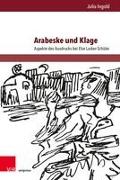Arabeske und Klage
BücherAngebote / Angebote:
Else Lasker-Schüler drückt mit ihren Formen, Inhalten, Texten und Bildern performativ die Möglichkeit der Ausdruckslosigkeit aus. Sie schildert grauenvolle Szenen in ostentativ poetischen Bildern. Nebenher kommentiert und zitiert sie ihre eigenen Werke kontinuierlich selbst. Beide Eigentümlichkeiten gehen auf das transmediale Gestaltungsprinzip der Arabeske zurück. Die Arabeske kann nicht nur als schmückender Rahmen dienen, sondern auch als Versteck, das Ausdrucksverbote hinterläuft. Julia Ingold stellt heraus, dass der Nachweis dieses Gestaltungsprinzips eine bisher unterschätzte Nähe Lasker-Schülers zur jüdischen Schrifttradition offenbart. Lasker-Schüler schreibt ihren Arabesken die Prekarität des Ausdrucks von Leid und Ungerechtigkeit ein - ihr künstlerischer Ausdruck impliziert die Möglichkeit des Schweigens.In her forms, contents, texts and images Else Lasker-Schüler expresses performatively the possibility of the lack of expression. She describes terrible scenes in ostentatiously poetic pictures. On the side she herself comments and quotes constantly her own works. Both peculiarities stem from the same transmedial formal principle of the arabesque. The arabesque can not only serve as decorative frame, but also as hiding place to evade the prohibition of representation. The proof of this formal principle reveals Lasker-Schüler's long underestimated influences of the Jewish scriptural tradition. In her arabesques Lasker-Schüler captures the precarity of the expression of distress and injustice - her artistic expression implies the possibility of silence.
Folgt in ca. 2-3 Arbeitstagen


